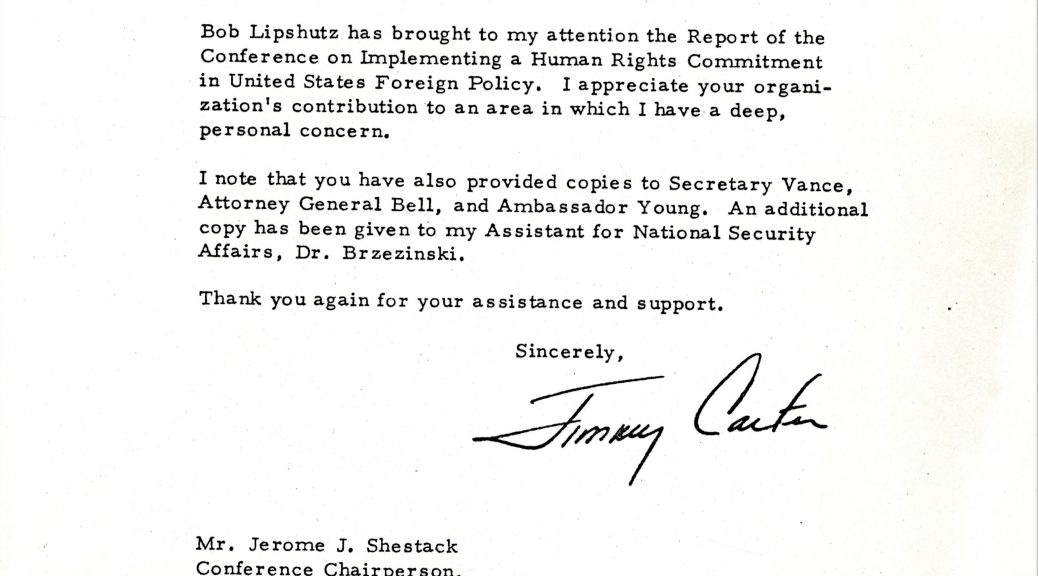Post contributed by Emma Evans, Marshall T. Meyer Intern at the Human Rights Archive

Hello! My name is Emma Evans, and I am a first-year Masters of Library Science student at UNC Chapel Hill. This year I have had the privilege to serve as the 2017-2018 Marshall T. Meyer Intern in the Human Rights Archive at the Rubenstein Rare Book and Manuscript Library. As an intern, I have had the opportunity to experience many aspects of archival work, including the arrangement and description of collections, collectively known as archival processing. Processing a collection is like putting together a puzzle — it can be a complex, interesting, and occasionally daunting task. When all the pieces are put into place, however, the process is ultimately very rewarding. This was my experience as I processed the Jerome J. Shestack papers. The numerous hours that I spent with his files rewarded me not only with archival processing experience, but with a newfound understanding of the need to preserve and convey human rights narratives through the archive.
Jerome J. Shestack was a prominent Philadelphia-based lawyer known for his extensive work and leadership as a human rights advocate. His work aimed to bring justice and equality to marginalized groups both in the US and around the world. He is perhaps most well-known for his position on the 1987 judicial committee that voted against US Supreme Court nominee Robert Bork, his fight against the mistreatment of political dissidents like Andrei Sakharov, and his leadership as 1997-1998 President of the American Bar Association. These significant moments in his career are well-documented throughout his papers in the form of correspondence, reports, and subject files, and other documents. However, Shestack’s work in law and human rights did not begin and end with these events. His papers also document his lifelong dedication to these efforts as a leading member in 13+ law and human rights advocacy organizations, a leading member of numerous professional committees, a frequent author and speaker, and a well-respected colleague. As Shestack spent the majority of his life working towards justice and equality for all people, the papers span over 60 years (1944-2011, bulk 1965-2000), and are now housed across 85 archival boxes. The collection is divided into six series: American Bar Association, Organizations, Correspondence, Subject Files, Writings and Speeches, and Print Materials, with the majority of files pertaining to Shestack’s professional life.
While arranging and describing the collection, I was constantly in awe of Shestack’s commitment to “taking action” for the cause. His papers make it evident that he never stopped working for the things he believed in. He was constantly speaking at law and advocacy events, attending conferences, writing reports, and providing commentary on public policy. He often held leadership roles in multiple organizations at once, namely the American Bar Association, the International League for Human Rights, and the Lawyers’ Committee for Human Rights. These simultaneous appointments made it easy for him to combine his passions of law and human rights to form organizational alliances and work toward common goals. On the other hand, these simultaneous appointments could make archival arrangement challenging, as a document would often describe the work of multiple organizations, making it unclear where it would best fit in the collection. Even so, this challenge further demonstrates Shestack’s steadfast dedication to doing whatever he could to advance universal human rights.

This dedication did not go unnoticed. Shestack was frequently praised for his actions by lawyers, human rights advocates, and politicians alike. His widespread recognition in his professional life gave him the platform to correspond and interact with many influential leaders, including but not limited to George Bush, René Cassin, and Martin Luther King, Jr. Correspondence between Shestack and these leaders are included in the collection, and these documents effectively demonstrate Shestack’s work and recognition in action. Furthermore, in some cases, this recognition would lead to further opportunities for leadership. In 1963, he became a member of the first Board of Trustees of the Lawyers’ Committee for Civil Rights Under Law, an organization formed at the request of President Kennedy. In 1979, President Jimmy Carter appointed Shestack as the US Ambassador to the UN Commission on Human Rights. His work in both of these appointments is represented within the collection through reports, correspondence, and certificates.
Overall, my experience processing this collection was both challenging and fulfilling. The significance of Shestack’s work in law and human rights advocacy revealed itself throughout the course of the project, and I enjoyed discovering his narrative, an important addition to the Human Rights Archive.
Take a look at the new collection guide for the Jerome Shestack papers online, or visit the Rubenstein Library’s reading room (open to the public) to view the materials.


